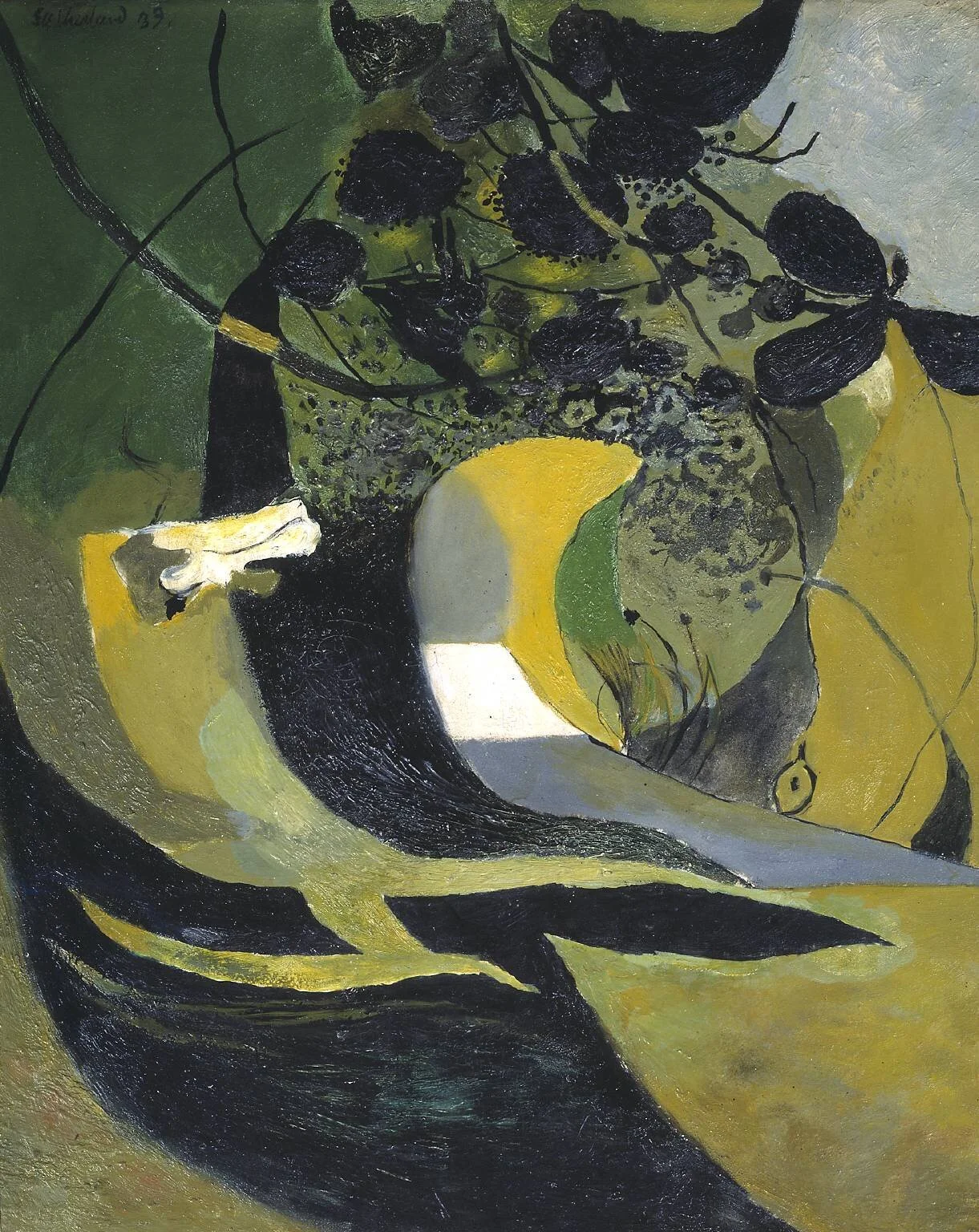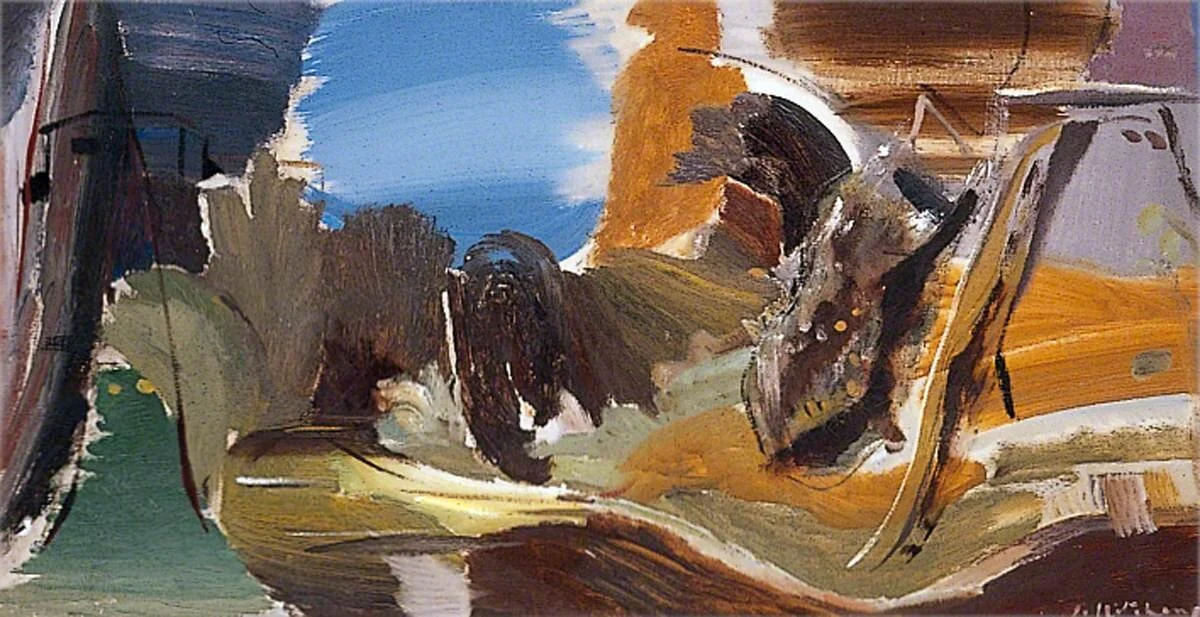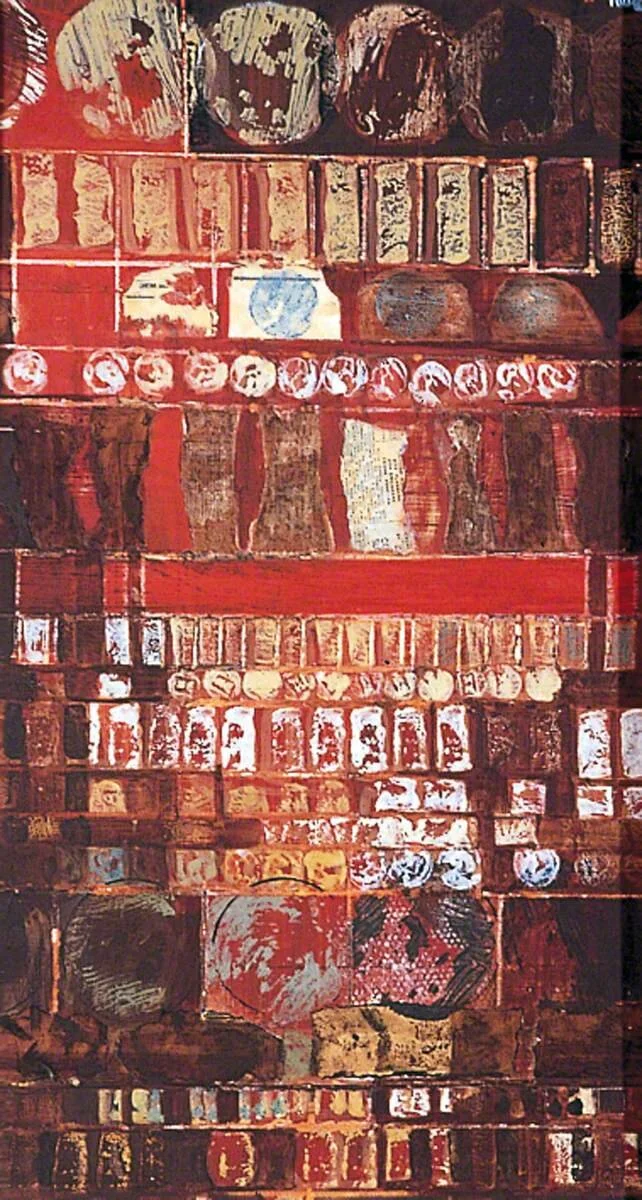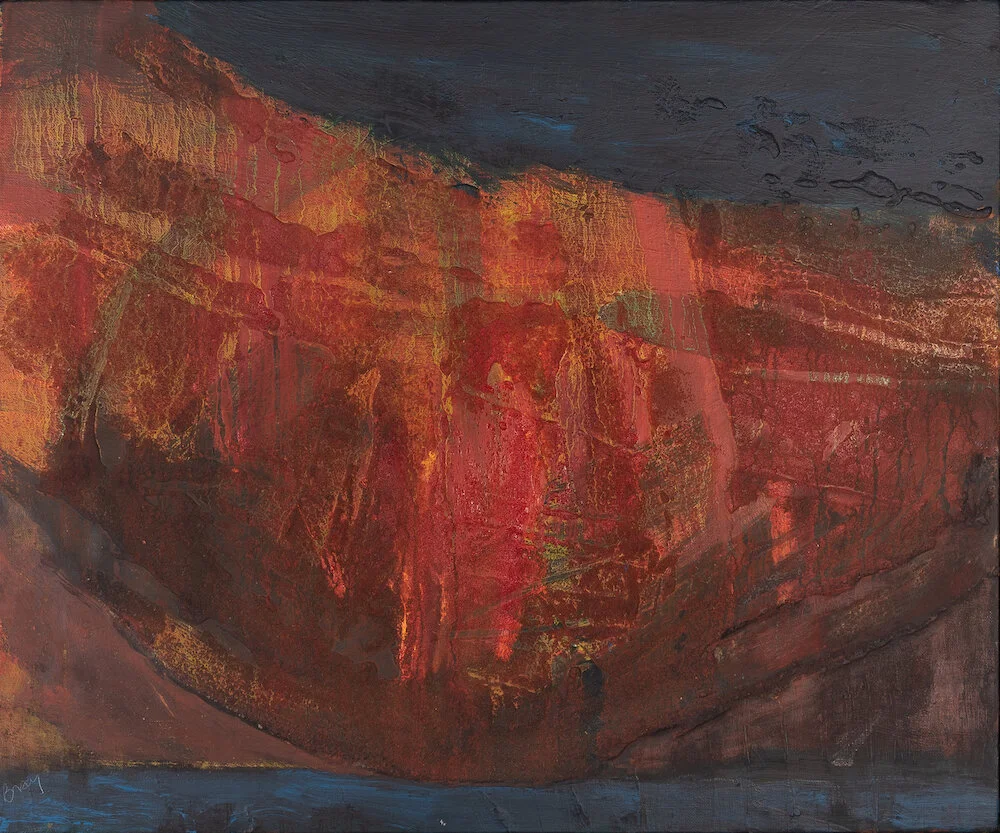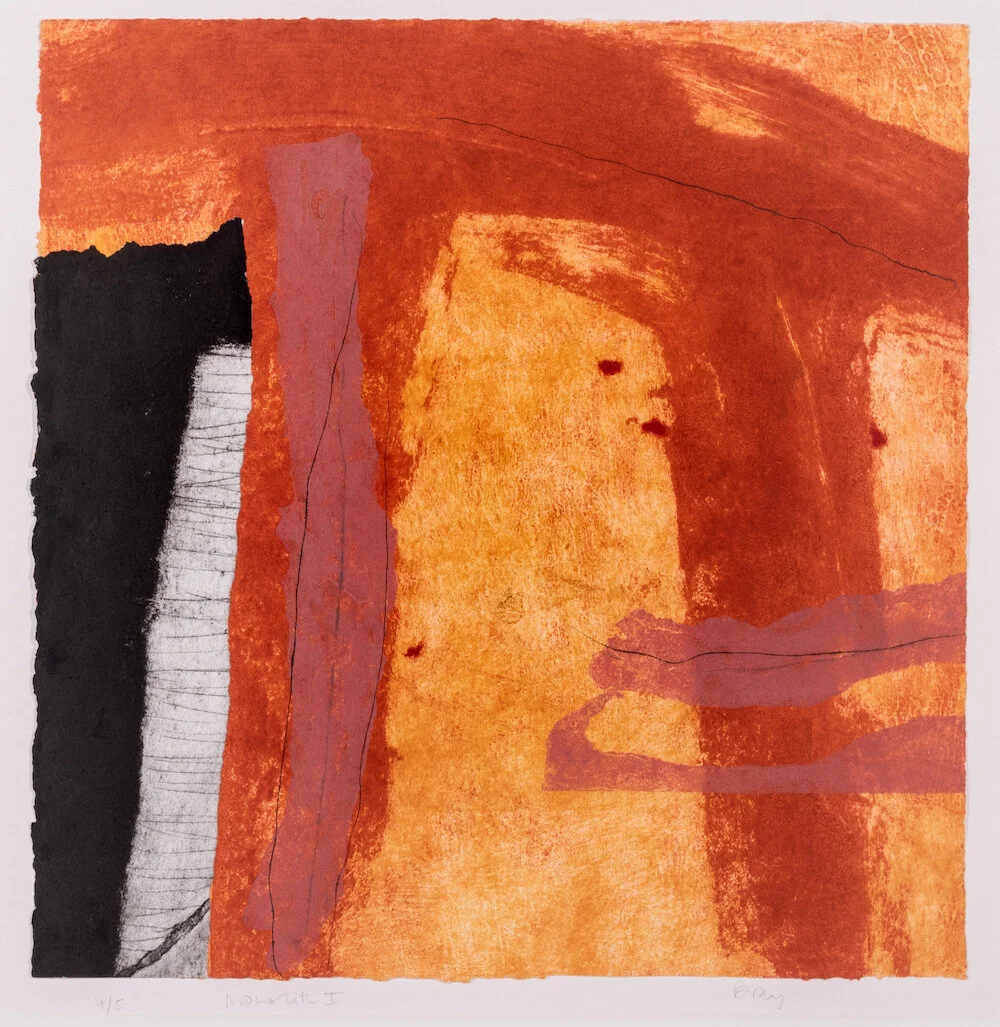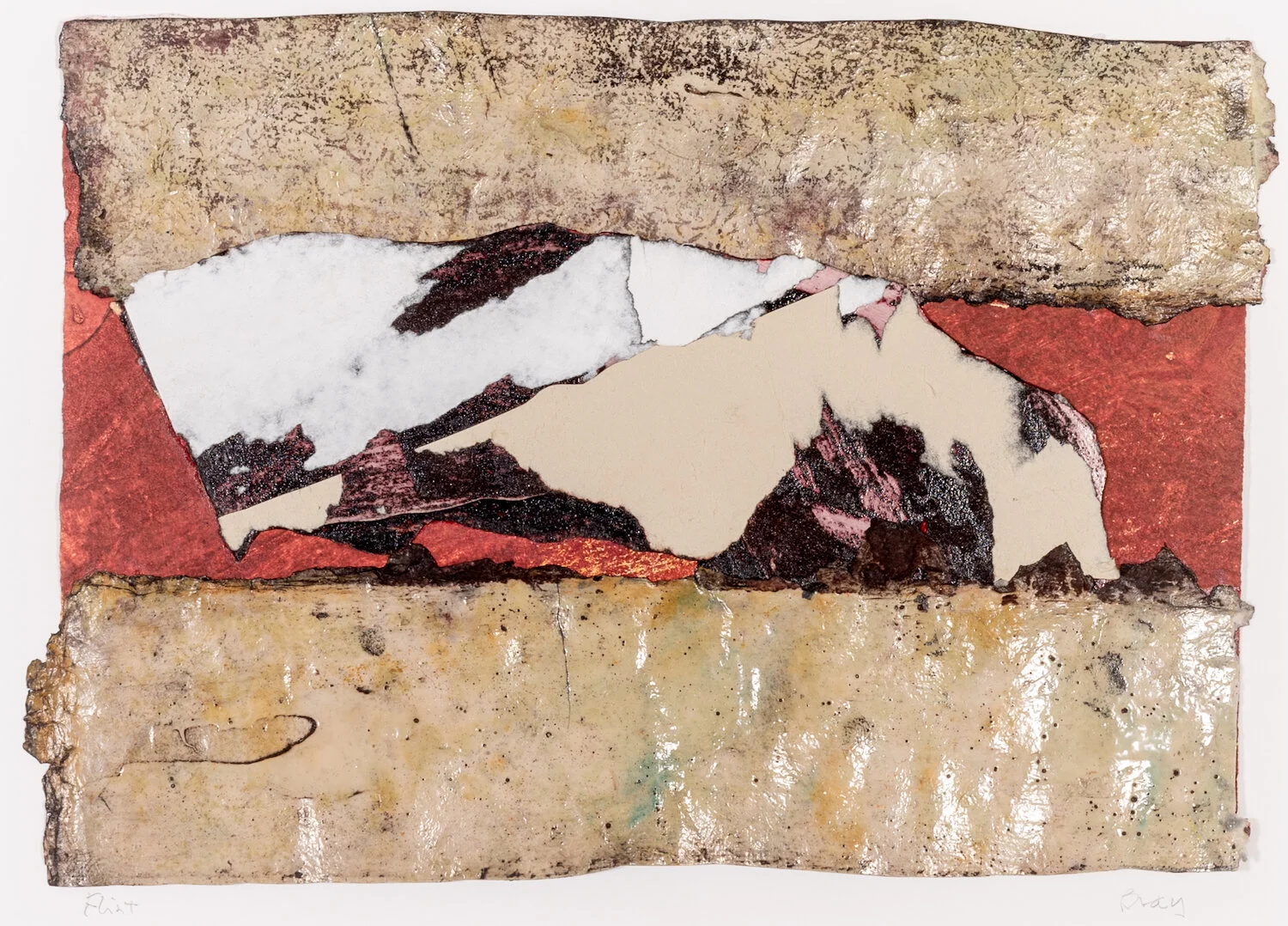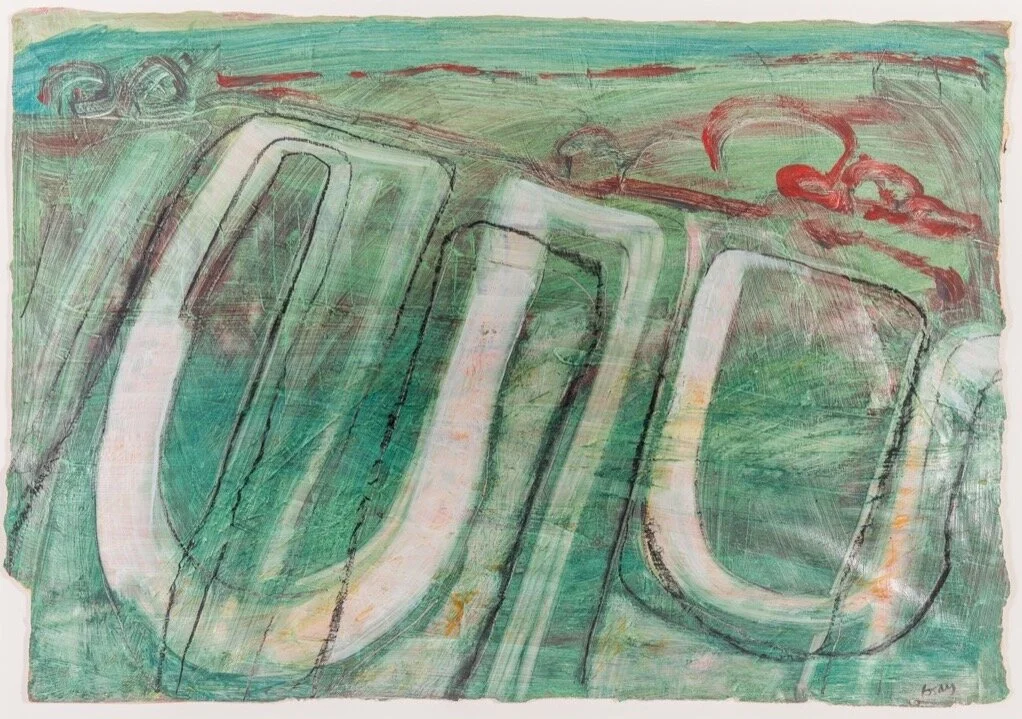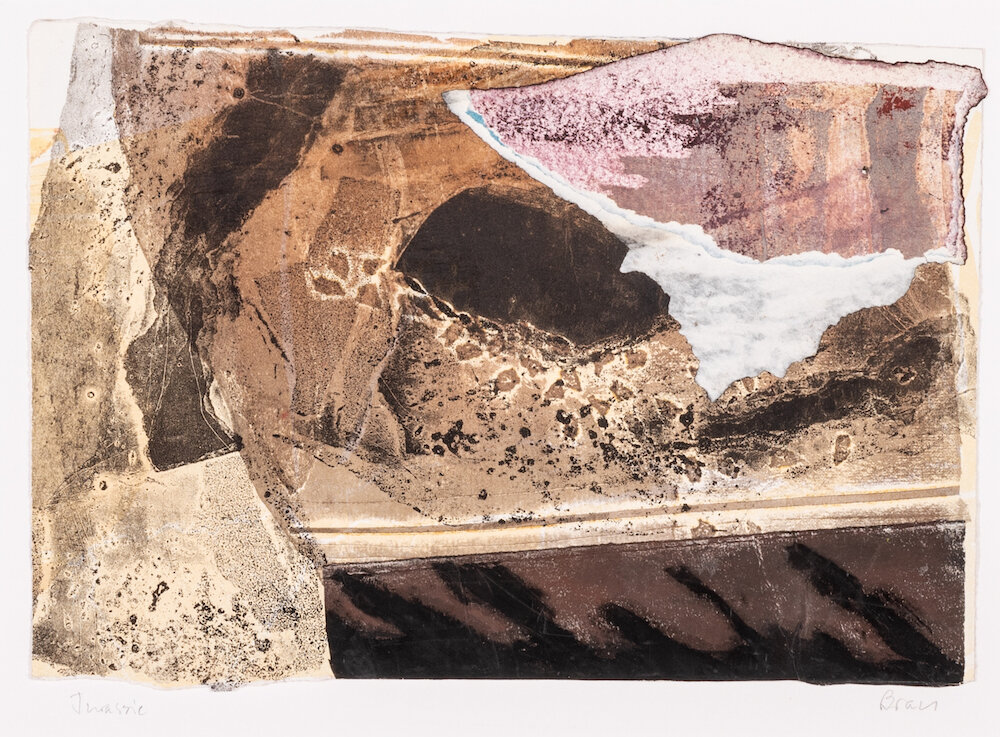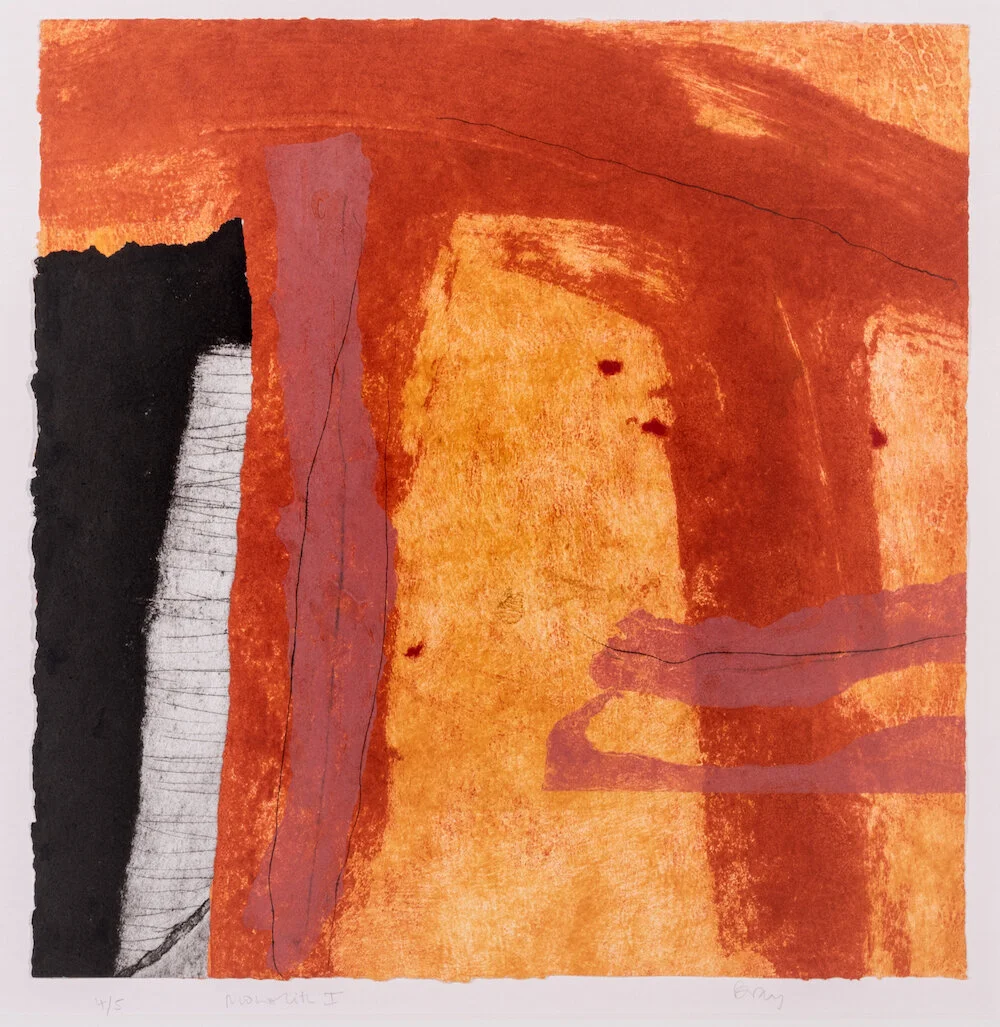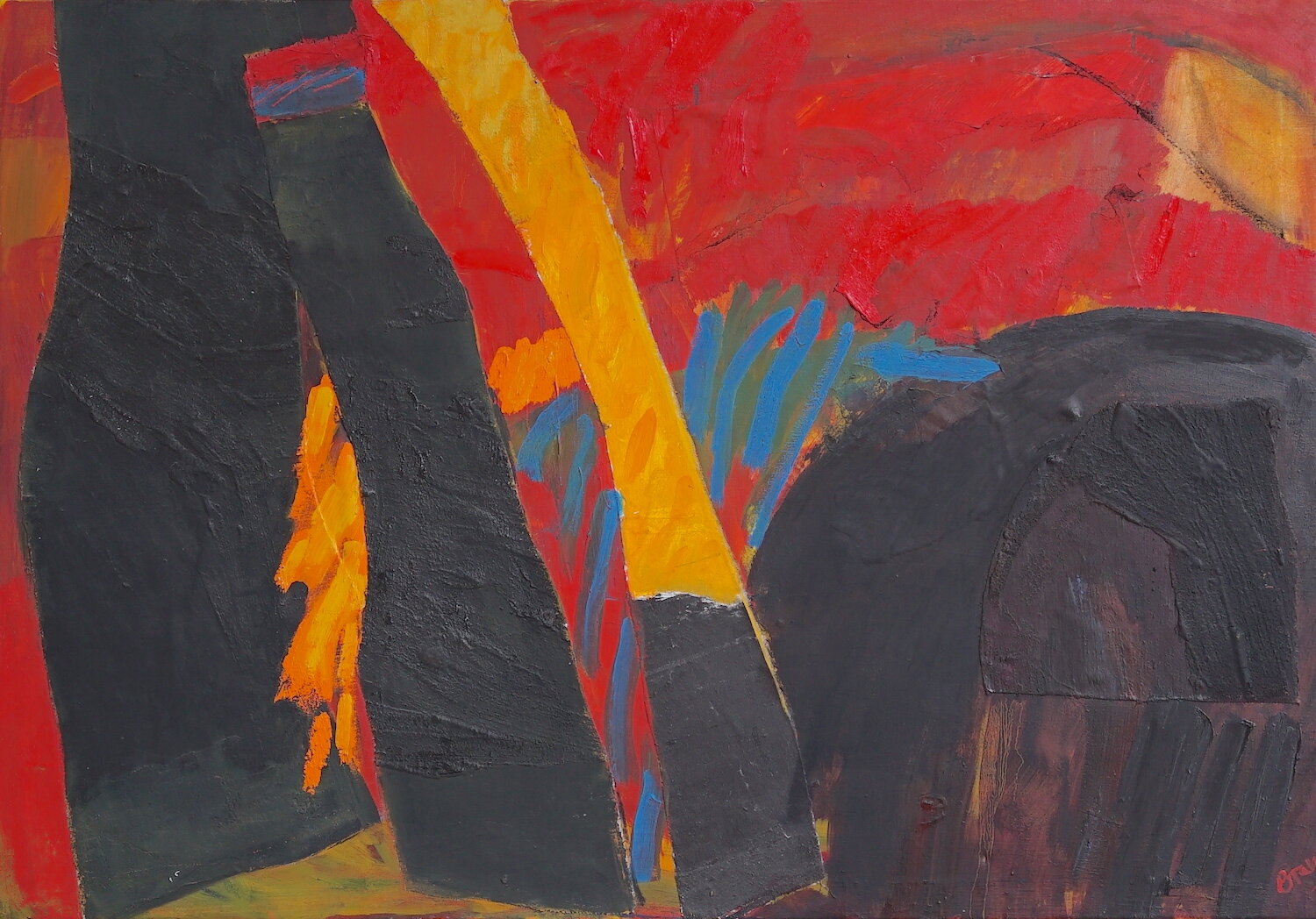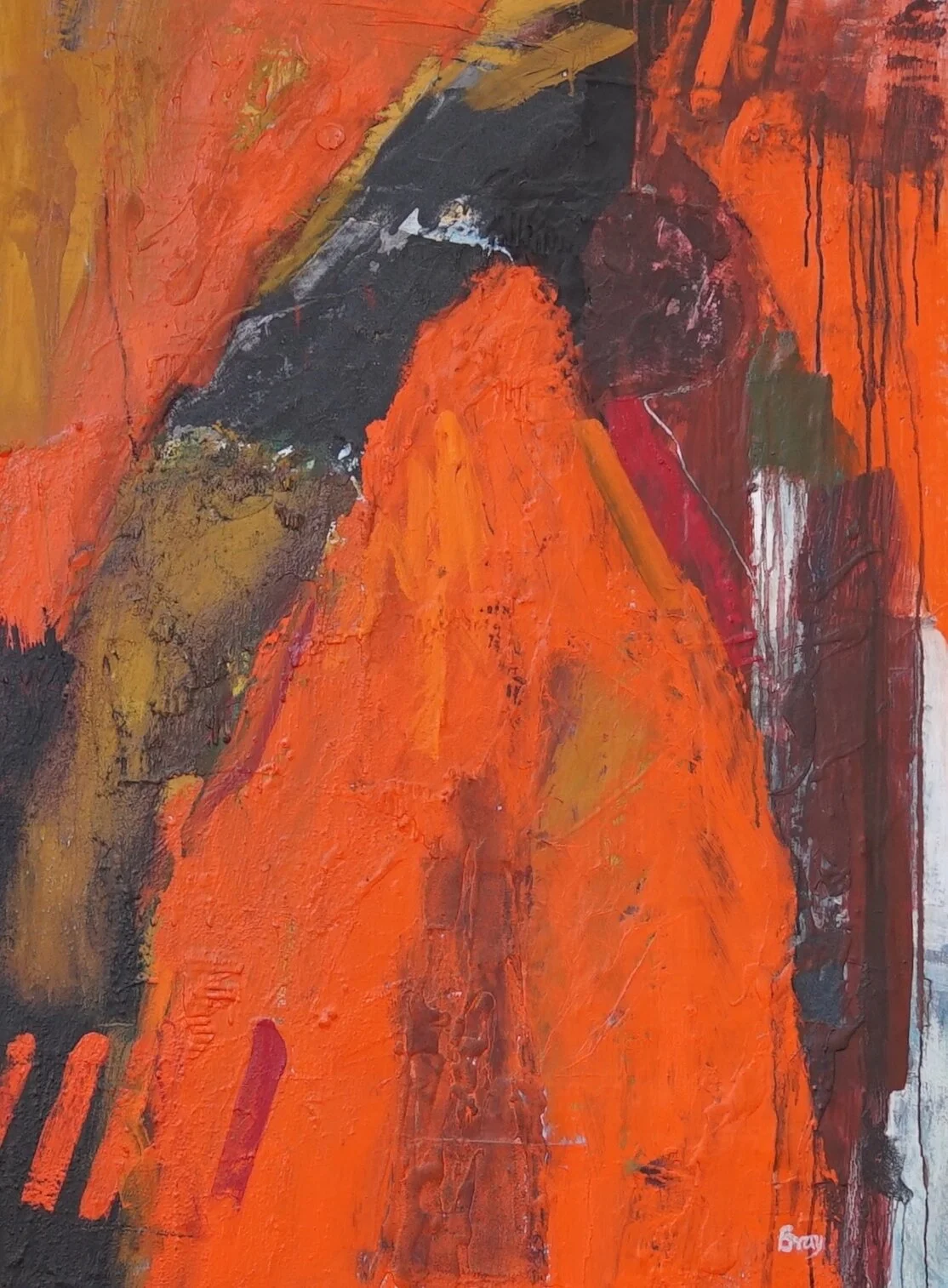Jill Bray: Making Her Mark
An essay to accompany Jill Bray. Earth Lines, A Retrospective
Kevis House Gallery, Petworth, 15 – 31 July 2021
By Dr Gillian Clarke, biographer and art historian, former Visiting Professor and Guest Curator, the Otter Collection, University of Chichester.
Dr Gill Clarke
Painter and printmaker Jill Bray (b. 1936) has over the past four decades created an extensive and unique body of work inspired by her abiding interest in the landscape. In particular she has been fascinated and challenged by the marks made upon it by ‘man’ and also with the edges of the land and landmass. It is both abstract and referential, her layering of marks mirroring the archaeology of ancient sites and traces of land usage that remain in the landscape.
This essay and the exhibition “Earth Lines'‘ and traces Bray’s artistic path and offer insights into the significant body of work that she has produced, which is held in both private and public collections.
Throughout her artistic career Bray has continued to develop her ideas as signalled in her early work exploring her abiding interest in the textures and colours created by collagraphic means and actual collages of her original prints. Skilfully manipulating carborundum and ink to suggest ‘man’s’ marks on the land, including the scar left by the cutting of the M3 through Twyford Down, near Winchester in the late 1980s-1990s. This ‘scar’ and ‘wound’ as she saw it and the anger she felt at the loss of this unique environment and the eventual sealing up of the surface with miles of tarmac strongly influenced her subsequent work including her expressive Twyford Down Series of collagraphic prints.
Graham Sutherland (1903-1980), who began his career as a printmaker observed in ‘The New Statesman and Nation’ in 1947 that: "Painters are affected by things which come to them from all over the place; from many kinds of painting and from many things. One absorbs what one needs at a given time." While Bray was no exception, she consistently sought to develop a style of her own avoiding slavish imitation. An admirer of Sutherland’s work she recognised how he would soak up the atmosphere of a particular place notably the distinctive Pembrokeshire landscape and allow the sensations to imbue his landscapes as in Entrance to a Lane (1943). Bray had been captivated by the painting when she first saw it as a student in 1954 at Bishop Otter College (now the University of Chichester) hanging on the College walls. It was not the only original work of art that she was be influenced by over the next two years of her art and music course for women teachers.
Graham Sutherland (1903–1980) Entrance to a Lane. © Tate.
Ivon Hitchens (1893–1979). Autumn Stream. University of Chichester, Otter Gallery © the artist's estate.
Peter Lanyon (1918–1964) The Green Mile University of Chichester, Otter Gallery © Sheila Lanyon. All rights reserved, DACS 2021.
By 1955 fellow students, staff and visitors to the College could see more original work by some of the most important figures in twentieth-century British art including Henry Moore, Paul Nash, John Piper, Peter Lanyon and Ivon Hitchens, hung around the College simply where they looked right. Hitchens’ (1893-1979) Autumn Stream, with its fluid sweeping brushstrokes made an impact, particularly his use of tone and colour to convey the essence of the object. Lanyon’s (1918-1964) The Green Mile (1952), one of his thin, tall vertical paintings inspired by the granite boulders, dry stone walls and lichen forms between St Ives and the distinctive headland of St Just, left an impression too. Particularly the way he incorporated references to geology, history and culture within his work.
Jill Bray. Red and Brown Abstract. University of Chichester, Otter Gallery
These paintings were purchased by two remarkable women: Sheila McCririck (1916-2001) and College Principal K.M. Elisabeth ‘Betty’ Murray (1909-1998). McCririck, Head of Art, and an influential teacher inspired the young Bray long after she had left Bishop Otter College. Indeed, it was McCririck’s unerring selecting eye that led to the purchase of some of the finest works in the Bishop Otter Art Collection.
While I was Visiting Professor and guest curator of the University’s Otter Gallery (closed in 2018) I was able in 2016 to write the history of this remarkable Collection. I was unaware at the time that one of McCririck’s last purchases in 1975 (before retiring two years later) was Bray’s early oil and collage Red and Brown Abstract, also known as Windows I (undated), from the Westgate Gallery, Winchester. The connection continued when Bray’s first two women exhibition "Land Shapes" was held in The Mitre Art Gallery at Bishop Otter College in 1991. It showcased her collagraphic work based upon natural shape and colour, alongside ceramics by another Hampshire artist, Joy Hadfield.
Like many women artists of the period Bray had to wrestle with domestic responsibilities and the bringing up of two sons, supported by her husband Ian who encouraged her artistic endeavours. Her creativity found an outlet through teaching the piano to private pupils, but it was only in the mid 1980s following moving to Soberton Towers, in the Meon Valley, Hampshire that she had her own studio. In addition, she could walk out into the countryside from her front door.
Family holidays afforded opportunities to find material and inspiration for her art. The rock formations of Dorset’s Jurassic coast provided much to marvel at. Like John Piper (1903-1992) and Paul Nash (1889-1946) she was drawn to the topography of Dorset’s dramatic shoreline including the Isle of Portland and its centuries-old history of stone quarrying, the remnants of which are marked indelibly on the landscape by abandoned quarries and caves carved out by the cutting of stone. Holidays to the Gower coast and Pembrokeshire (see Pembroke I, oil and sand on canvas) also provided inspiration as did the foreboding and mysterious Black Mountains which greatly intrigued her. Bray’s Welsh Rock (1979) resulted from one such holiday and points to her growing ability to extract the essence and spirit of a place.
In 1979 Bray gained her Diploma in Fine Art from Southampton College of Art. This marked a turning point in her career as she discovered printmaking having been given the run of the print studio in her final year and the chance to experiment with printing from found objects. Bray’s enthusiasm and passion for the medium led to her attending three annual printmaking Summer Schools in the late 1980s run by Michael Honnor (b.1944) at Wilkey’s Moor Print Workshop, attached to a remote farmhouse on the edge of Dartmoor, where she honed her skills in this unique landscape. She also gained much from attending courses with Michael Griffiths (b.1951) in Winchester in 1990. Bray exhibited widely during the 1990s having work accepted for touring shows to Reykjavik, Duisburg, Amsterdam, Aarhus, Bratislava and Moscow. She had success in numerous mixed and open exhibitions, including The Royal West of England Academy, Bristol where she first exhibited in 1983 and where in 1997 she showed the carborundum print Crossing IV alongside work by her former tutor Michael Honnor, and Emma Stibbon, later elected Royal Academician. Bray’s work featured in many exhibitions including at the Flowers Gallery; Curwen Gallery; and the Royal Festival Hall in ‘The Art of the Printmaker’. She also had several solo shows, notably ‘Drawings and Collages’ at The Gallery, Nuffield Theatre, Southampton.
As a member of the Printmakers Council, Bray had work accepted for their exhibitions including 'Paintings and Prints' at the Barbican in summer 1993. She was also involved with the group 2D3D South whose members work in a range of disciplines within the visual arts. It was a busy creative period for Bray, her work continued to be well received and influenced by the cliffs and field patterns of southern England, these interests were reflected in both the titles of her increasingly assured work and exhibitions. For example, 'Land Marks', a solo show at The Old Town Hall, Havant; 'Earth Matters' with Carl Danby (b.1938) and Gill Horn (b.1949) at Bedales Gallery near Petersfield in 1994 which included sculpture, drawings, and paintings by the three artists. Bray was by then living close to the ancient site of Winchester Hill, an iron-age fort, and reference to the topography and history of the area was much in evidence in her prints.
Monolith I. Carborundum print and collage.
Bray on occasion joined Horn to sketch the local landscape but preferred to use her camera to record marks in the landscape and interpret actual experiences, in her studio. She later used her single lens reflex camera to effect taking photographs for inclusion in ‘textures’, a book (unpublished) about textual beauty and what it meant to her. Her photographs are in intent the same as those of her printmaking eschewing the picturesque, and show how she found meaningful textures in not only rock formations and the strata of cliff faces but also in old walls or in the tarmac of a road. Paul Nash made great use of what he called "the camera’s eye"; 'Fertile Image' (1951) published after his death and edited by Margaret Nash included the highly personal and meaningful photographs, he had taken between 1931-1946 for use in his painting. They show his fascination particularly with the seashore, rock formations, monoliths and the like (see Bray’s carborundum print and collage Monolith I, 1980) and the rhythms of the land and sea. For Bray, who had briefly taught English, actual words and their meaning could be textural and evocative (as seen in the carefully chosen titles of her work and exhibitions). Alongside her chosen images sit words largely in the form of poetry, including 'The Cragsman' by Geoffrey Winthrop Young; 'Hardcastle Crags' by Sylvia Plath; 'In Praise of Limestone' by W.H. Auden; 'That Lance of Light' by Mervyn Peake and 'Everyone Sang' by Siegfried Sassoon, perhaps a nod to her love of music. textures with its compelling mix of word and image has echoes of the work of acclaimed photographer Fay Godwin (1931-2005) who with her stark and sombre, elegiac photographs documented in unsentimental yet creative ways the changing British landscape she stridently cared for. Godwin unlike Bray, however, was able to collaborate with writers to reveal what were in many ways similar interests in the traces and marks left behind by people and events. A founder member of Winchester Contemporary Art with Michelle Griffiths (now Vice President of the Royal Society of Painter Printmakers) and Ursula Leach RE, Bray’s collagraph and carborundum print Twyford advertised the 1995 exhibition 'A Feeling for Landscape’ held at the Gallery in Great Minster Street where she exhibited with another founding member Angela Anson. The following year Bray joined five other members in ‘Artists’ Choice’ when they invited artists whose work, they admired to exhibit alongside them. She selected Larry Wakefield (1925-1997) whom she’d likely met during her Diploma studies in Southampton. Other notable invited artists included William Crozier (1930-2011) and Breon O'Casey (1928-2011). It was Wakefield’s tenacity, sense of purpose and ability to use colour to suggest mood that Bray admired together with his abstraction of landscape. Attributes she sought within her own work, indeed her adept use of colour emphasises the mystery and timelessness of the landscape. In this respect she was also drawn to work by the acclaimed colourist Howard Hodgkin (1932-2017) admiring his fine paintings and prints which were layered with remembered experiences.
Bray’s statement to accompany the important exhibition ‘Landmark. A Survey of Contemporary Landscape Painting’ held at the Atrium Gallery, University of Bournemouth in 1998 made explicit her debt to Peter Lanyon and how his work enabled her to better understand the landscape. She explained, “His over-layering of marks, his challenging of nature’s colours and his exploitation of the medium reflected a conscious search into new ways of presenting the subject.” Bray recognised how in his later work collage became important, it is significant that in her own painting and printmaking as mentioned she successfully used layering to mirror the archaeology and traces of land usage found in the Hampshire landscape. Her collages, with torn edges relate to the stratified layers of cliffs and the edges where the land meets the sea. Bray’s work held its own alongside work by esteemed artists with strong connections to the Dorset landscape including Jeremy Gardiner (b.1957), Peter Joyce (b.1964), Brian Graham (b.1945), Michael Fairclough (b.1940) and Vanessa Gardiner (b.1960).
The following decade Bray had little time for her art as she was much occupied caring for her husband Ian following a major stroke in 2000. After Ian’s death in 2010 she was able to spend more time on her art, in particular making collages often incorporating pieces from older work. It was also a way to help her through her grief. She had inherited a powered press from a friend when they had moved to Fareham, which enabled her to print at home. Bray’s work was first shown at Kevis House Gallery, Petworth in 2016 as part of a show by the 2D3D South group, and Kevis House then took her on as a represented artist.
Not one to seek publicity, Bray’s modesty about her achievements has contributed to her work being overlooked in wider artistic circles. Her long overdue retrospective 'Earth Lines' at Kevis House Gallery is to be welcomed. It offers a unique opportunity to contemplate and appraise a significant and coherent body of work which merits attention. Jill Bray’s work is at all times deeply felt with a strong, expressive sense of place as she sought to push the boundaries of her art.
Gallery of all works in the exhibition:



